19 Jul 2017
Forty Hall Summer Dig - Day 7
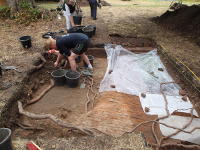
Thankfully the rain just about held off today, and last night's thunderstorms softened the ground just enough to make digging easier and less dusty than yesterday, not to mention giving our brick floors a handy rinse.
The southern extension to trench 2 made good progress today and is almost finished, uncovering more of the hardy brick surface within our palace building.
The upper floor surface has been truncated in a rough line across the length of the trench revealing, as we suspected earlier in the week, another brick floor beneath.
Similarly to the floor above it, this surface has bricks laid in more than one orientation and also has signs of repair and patching to it (perhaps one of the reasons a new floor was eventually laid on top). There may also be tentative signs of burning on the lower floor, but this will need closer examination tomorrow.
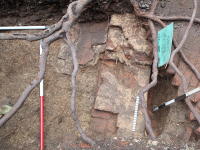
At the east end of trench 2 the large wall was fully excavated, including the disturbed remains of a few roof tiles, clearly deliberately laid along the front of the wall. We think this may be the remains of the base of a small drain set along the front of the original building.
Altogether, the structures in trench 2 are very complex and multi-phased and interpreting their relationships to each other will take some time. At the moment, we think the large wall (pictured) is the earliest phase, representing the original east end of the building, belonging to Sir Thomas Lovell's palace, circa 1490-1524, which was later remodelled probably by Henry VIII circa 1540, which involved demolishing the wall (probably to extend the building) and relaying the floor on top of it.
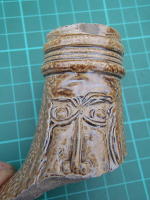
As mentioned yesterday, this year's dig has turned up quite a lot of stoneware fragments including pieces of decorated 'Bartmann' jugs, and today while drawing the north section of trench 2 we had a pleasant surprise when the bearded man himself put in an appearance (pictured).
Initial research has suggested that the stoneware fragment we found yesterday with the image of a man may also come from a Bartmann jug, which is quite unusual given that it is decorated in multi colour glaze (Bartmann jugs typically being monochrome).
The face on this fragment is quite a distinctive elongated shape, which should be highly dateable.
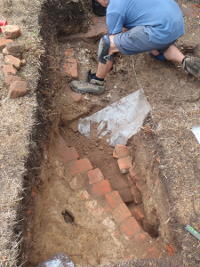
Trench one continues to throw curveballs - what we thought was the robbed out remains of a wall footing paralell to our large drain is now in fact almost certainly another drain, having been very severly disturbed by the roots of a now absent tree.
This new drain runs almost at ninety degrees to the larger one - a trench extension this afternoon established that the large drain truncates the smaller one, so must be later. As in trench 2 we think this may be more evidence of Henry VIII's remodelling of the palace some time after 1540.
Since the smaller drain has been cut through by the larger, we may further extend the trench in this area to see if and where it continues on the far side of the large drain.
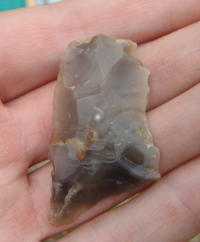
Every now and then we're given a welcome reminder that the Tudors were far from the first people to live in Forty Hall - today this came from the extension to the drain trench, which produced a lovely flint tool.
Prehistoric hunter-gatherers are known to have lived at least briefly in this area of Enfield particularly in the late Neolithic/Early Bronze age, but this tool is probably earlier being typical of the kind of tool produced in the Mesolithic period, around 7,000 to 11,000 years ago, making Henry VIII seem like yesterday!